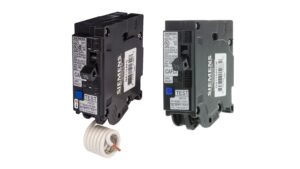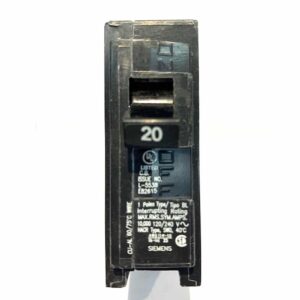What is a Piggyback Breaker and Advantages & Types .A Piggyback Breaker, also known as a tandem circuit breaker, is a type of electrical circuit breaker that fits two independent circuit breakers into the space of a single breaker slot on a standard circuit breaker panel.
This design is particularly useful in residential and commercial electrical systems where the breaker panel space is limited.
What is a Piggyback Breaker?
A piggyback breaker consists of two miniature circuit breakers stacked one over the other, sharing a single breaker slot in the panel. Each breaker operates independently, protecting separate circuits, yet they fit within the space allocated for just one standard single-pole breaker. This space-saving feature is particularly beneficial in older electrical panels that have a limited number of breaker slots but require the addition of more circuits.
Types of Piggyback Breakers
- Single-Pole Tandem Breakers: These have two single-pole breakers in the space of one.
- Double-Pole Tandem Breakers: These can accommodate two double-pole circuits, but they are less common.
- Combination Tandem Breakers: These include a mix of single-pole and double-pole breakers.

How Piggyback Breakers Work
Each breaker within a piggyback breaker has its own trip mechanism and can control and protect a separate circuit. When an electrical fault such as an overload or a short circuit occurs on any of the circuits, the corresponding breaker will trip and cut off the power supply to that circuit. This isolation helps in preventing electrical fires and damage to electrical devices.
Advantages of Piggyback Breakers
Space Efficiency
1. Maximizing Panel Capacity: The primary advantage of piggyback breakers is their ability to maximize the capacity of an electrical panel. In older homes or buildings, the electrical panel may have a limited number of slots, and upgrading to a larger panel can be expensive and disruptive. By using tandem breakers, you can add additional circuits without the need for panel upgrades.
2. Cost-Effective Solution: Instead of incurring the costs associated with installing a new, larger panel, piggyback breakers provide a more economical solution. This is especially beneficial for homeowners and small businesses looking to expand their electrical capacity without substantial investment.
Flexibility
3. Accommodating Growing Electrical Needs: Modern homes and businesses have increasing electrical demands due to the proliferation of electronic devices, appliances, and smart home technologies. Piggyback breakers offer the flexibility to add new circuits to meet these growing needs without significant reconfiguration of the existing electrical system.
4. Easy Installation: Installing a piggyback breaker is relatively straightforward and does not require specialized tools or extensive rewiring. Electricians can quickly and easily install these breakers, minimizing downtime and inconvenience.
Safety
5. Independent Circuit Protection: Each breaker within a piggyback breaker operates independently, ensuring that each circuit is protected separately. This independence enhances safety by isolating electrical faults to the affected circuit, reducing the risk of fire and equipment damage.
6. Compliance with Electrical Codes: Piggyback breakers are designed to meet the same safety standards and electrical codes as standard breakers. They undergo rigorous testing to ensure they provide reliable protection and meet the requirements of organizations like Underwriters Laboratories (UL).
Practical Applications
7. Renovations and Upgrades: During renovations or upgrades, particularly in older buildings, it is often necessary to add new circuits for additional lighting, outlets, or appliances. Piggyback breakers are ideal for these scenarios, allowing for circuit expansion without the need for a new panel.
8. Temporary Needs: For temporary installations or projects that require additional circuits for a short period, piggyback breakers offer a practical solution. They can be easily installed and removed as needed, providing a flexible option for temporary electrical needs.
Economic and Environmental Benefits
9. Cost Savings: By avoiding the need for panel upgrades, piggyback breakers save money on both materials and labor. The installation is simpler and faster, which translates to lower overall costs.
10. Reduced Waste: Reusing the existing electrical panel and adding piggyback breakers reduces the waste associated with replacing an entire panel. This approach is more environmentally friendly as it minimizes the materials sent to landfills.

Examples of Usage
- Residential Use: In homes where the electrical panel is full but additional circuits are needed for new appliances, lighting, or home office equipment, piggyback breakers provide an effective solution.
- Commercial Use: Small businesses, particularly those in older buildings, can benefit from the space-saving feature of piggyback breakers when expanding their electrical system to accommodate new equipment or office spaces.
- Industrial Use: In industrial settings where space is often at a premium, piggyback breakers can be used to add circuits for machinery and equipment without overhauling the electrical infrastructure.
Considerations and Limitations
While piggyback breakers offer many advantages, there are some considerations and limitations to keep in mind:
1. Electrical Load Management: It is essential to manage the overall electrical load on the panel. Overloading the panel can lead to overheating and potential hazards. Consulting with a licensed electrician ensures that the addition of piggyback breakers does not exceed the panel’s capacity.
2. Compatibility: Not all electrical panels are compatible with piggyback breakers. Some panels are specifically designed to prevent the use of tandem breakers, so it’s important to verify compatibility before installation.
3. Code Restrictions: Local electrical codes and regulations may have specific requirements regarding the use of tandem breakers. It is crucial to comply with these codes to ensure safety and avoid legal issues.
4. Proper Identification: Clear labeling of circuits is essential when using piggyback breakers. Proper identification helps in troubleshooting and ensures that each circuit can be easily located and managed.
Conclusion
Piggyback breakers are a practical and efficient solution for expanding the capacity of an electrical panel without the need for a complete overhaul. They offer significant advantages in terms of space efficiency, cost savings, flexibility, and safety. By allowing the addition of more circuits within the existing panel space, they meet the growing electrical needs of modern homes and businesses. However, it is important to consider the limitations and ensure proper load management, compatibility, and adherence to local codes to maximize the benefits and maintain safety. Consulting with a licensed electrician is always recommended to ensure a safe and effective installation.
Read Also. What are the different types of electrical panels?